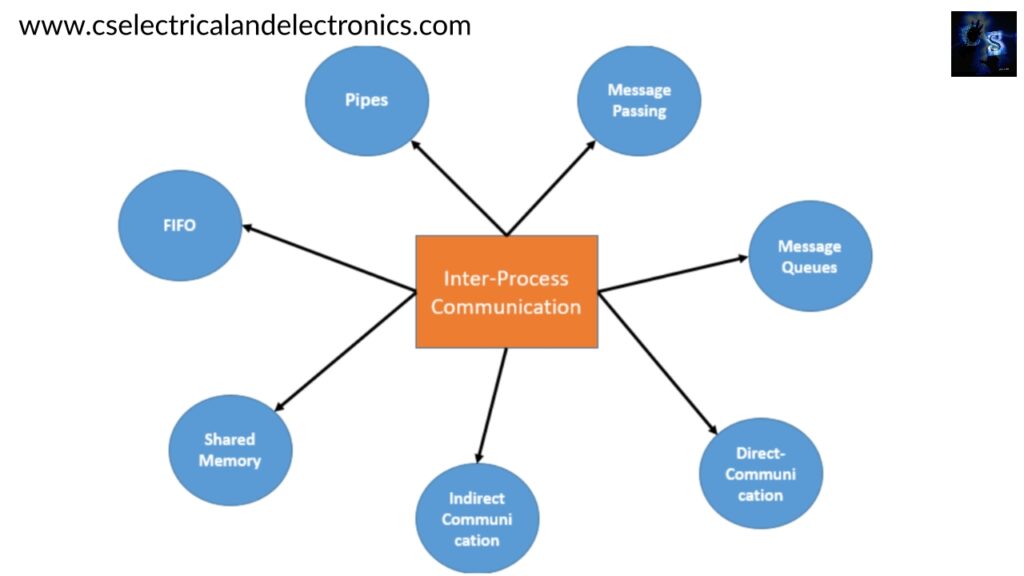What Is Inter-Process Communication In Operating System, Purpose
Hello guys, welcome back to my blog. In this article, I will discuss what is inter-process communication in the operating system, why inter-process communication is required, approaches for inter-process communication.
If you have any doubts related to electrical, electronics, and computer science, then ask question. You can also catch me @ Instagram – Chetan Shidling.
Also, read:
- Top Quiz Questions On Networking Asked During Online Test
- How to Setup QEMU For The Custom Kernel, Kernel Programming
- 1000+ Electronics Projects For Engineers, Diploma, MTech Students
What Is Inter-Process Communication
The operating system’s technique for allowing processes to communicate with one another is known as interprocess communication. This communication could include a process informing another process of an occurrence or data being transferred from one process to another.
Inter-Process Communication is a form of mechanism given by the operating system in general (or OS). This mechanism’s main purpose or goal is to facilitate communication between multiple operations. “Inter-process communication is a way for exchanging relevant data between numerous threads in one or more processes (or programs)”
Role of Synchronization in Inter-Process Communication
It is an important part of interprocess communication. This is typically given via interprocess communication control mechanisms, but communication processes can also control it.
The following are the methods that were employed to provide synchronization:
- Mutual Exclusion
- Semaphore
- Barrier
- Spinlock
Mutual Exclusion:- Only one process thread should be allowed to enter the critical part at a time. This also aids synchronization and generates a steady state to avoid a race condition.
Semaphore:- A semaphore is a sort of variable that manages several processes’ access to shared resources. Semaphore is further subdivided into two types:
- Binary Semaphore
- Counting Semaphore
Barrier:-
A barrier usually prevents an individual process from moving forward until all other processes have failed to reach it. Many parallel languages employ it, and collective routines erect obstacles.
Spinlock:-
As the name implies, a spinlock is a form of lock. While attempting to acquire the spinlock, the processes wait or stay in a loop, verifying whether the lock is accessible or not. The process is known as busy waiting because, despite being active, it does not perform any functional operations (or tasks).
Why IPC?
The following are some of the reasons why the interprocess communication protocol is used for information sharing:
- It facilitates modularity.
- Separation of computational privileges
- Convenience
- Aids operating systems in communicating with one another and coordinating their actions.
Approaches for Inter-Process Communication
Here, are a few important methods for interprocess communication:

01. Pipes
The pipe is a common way for two processes to communicate with one another. The first processor communicates with the second process because this is a half-duplex approach. A full-duplex connection, however, necessitates the use of another pipe.
02. Message Passing
It is a communication and synchronization mechanism for a process. The process communicates with each other using message passing rather than shared variables.
03. Message Queues
Within the kernel, a message queue is a linked list of messages. A message queue identification is used to identify it. This approach allows full-duplex communication between single or multiple processes.
04. Direct Communication
Should clearly name each other in this form of inter-process communication mechanism. A link is established between one pair of communication processes in this method, and only one link exists between each pair.
05. Indirect Communication
Only when processes share a common mailbox does indirect communication occur, with each pair of processes sharing many communication links. Many processes can communicate through a connection. The link can be bidirectional or unidirectional.
06. Shared Memory
Shared memory is a type of memory that is shared by two or more processes and is formed by using shared memory in all processes. This type of memory must be protected from each other by coordinating access across all processes.
07. FIFO
Two unconnected processes communicate with each other. It is a full-duplex approach, which implies that the first and second processes can communicate with one other, as well as the other way around.
To summarise, it is a set of programming interfaces that enable a programmer to coordinate operations among several concurrently running program processes in an operating system. This enables a program to handle a large number of user requests at the same time. Because each user request may trigger several processes in the operating system, the processes may need to communicate with one another. Because each IPC protocol style has its own set of benefits and drawbacks, it’s not uncommon for a single software to employ all of them.
This is about ” What Is Inter-Process Communication “. I hope this article may help you all a lot. Thank you for reading.
Also, read:
- 100 + Electrical Engineering Projects For Students, Engineers
- 100+ C Programming Projects With Source Code, Coding Projects Ideas
- 1000+ Electronics Projects For Engineers, Diploma, MTech Students
- 1000+ Interview Questions On Java, Java Interview Questions, Freshers
- 1000+ MATLAB Simulink Projects For MTech, Engineering Students
- 500+ Embedded System Projects For Engineer, Diploma, MTech, PhD
- 500+ Projects For Diploma Electrical, Electronics Student, Diploma Project
- 8051 Microcontroller Timers, TCON Register, TMOD Register
Author Profile
- Chetu
- Interest's ~ Engineering | Entrepreneurship | Politics | History | Travelling | Content Writing | Technology | Cooking
Latest entries
 All PostsApril 19, 2024What Is Vector CANoe Tool, Why It Is Used In The Automotive Industry
All PostsApril 19, 2024What Is Vector CANoe Tool, Why It Is Used In The Automotive Industry All PostsApril 13, 2024What Is TCM, Transmission Control Module, Working, Purpose,
All PostsApril 13, 2024What Is TCM, Transmission Control Module, Working, Purpose, All PostsApril 12, 2024Top 100 HiL hardware in loop Interview Questions With Answers For Engineers
All PostsApril 12, 2024Top 100 HiL hardware in loop Interview Questions With Answers For Engineers All PostsMarch 22, 2024Driver Monitoring Systems In Vehicles, Working, Driver Sleepy Alert
All PostsMarch 22, 2024Driver Monitoring Systems In Vehicles, Working, Driver Sleepy Alert








